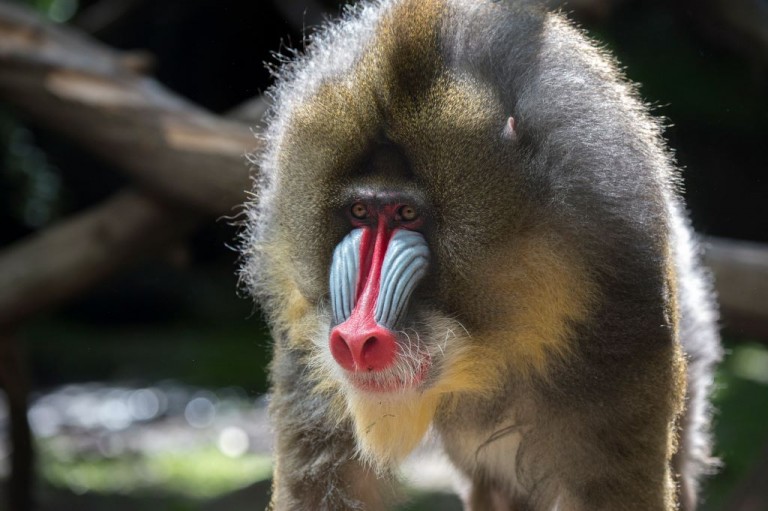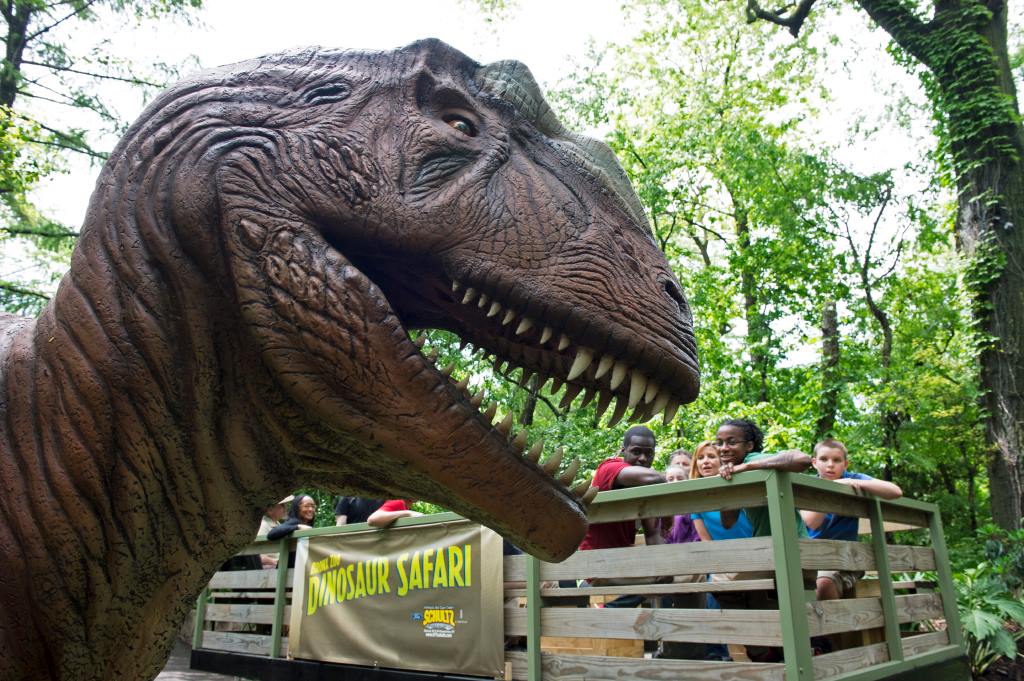
The Dinosaur Safari at the Bronx Zoo will run through Sunday, Sept. 8 and includes 20 life-like animatronic dinosaurs.
Whether it’s a trip through time to see dinosaurs or watching sea lions high-fiving humans, the Bronx and Queens zoos have you covered this summer.
The Wildlife Conservation Society’s wildly popular institutions have a number of new programs – and animals – that can keep people of all ages entertained throughout the dog days of summer.
At the Bronx Zoo, located at Fordham Road and the Bronx River Parkway, members of the public can see not only the 4,000 animals representing more than 650 species at one of the country’s largest wildlife conservation parks – but they can also take a peek into what the world used to be like millions of years ago.
The Bronx Zoo opened its “Dinosaur Safari” at the end of May, and the exhibit that includes more than 20 life-like animatronic dinosaurs – which snarl, roar and spit – will run through Sunday, Sept. 8.
The safari includes a narrated ride runs through a two-acre area of the zoo and highlights some of the similar physical and behavioral adaptations many prehistoric species share with modern-day wildlife. A guide helps to identify the dinosaurs – includes a 40-foot-long Tyrannosaurus rex and the long-necked Brachiosaurus – and explains how animals at the Bronx Zoo use similar adaptations to survive in the wild.
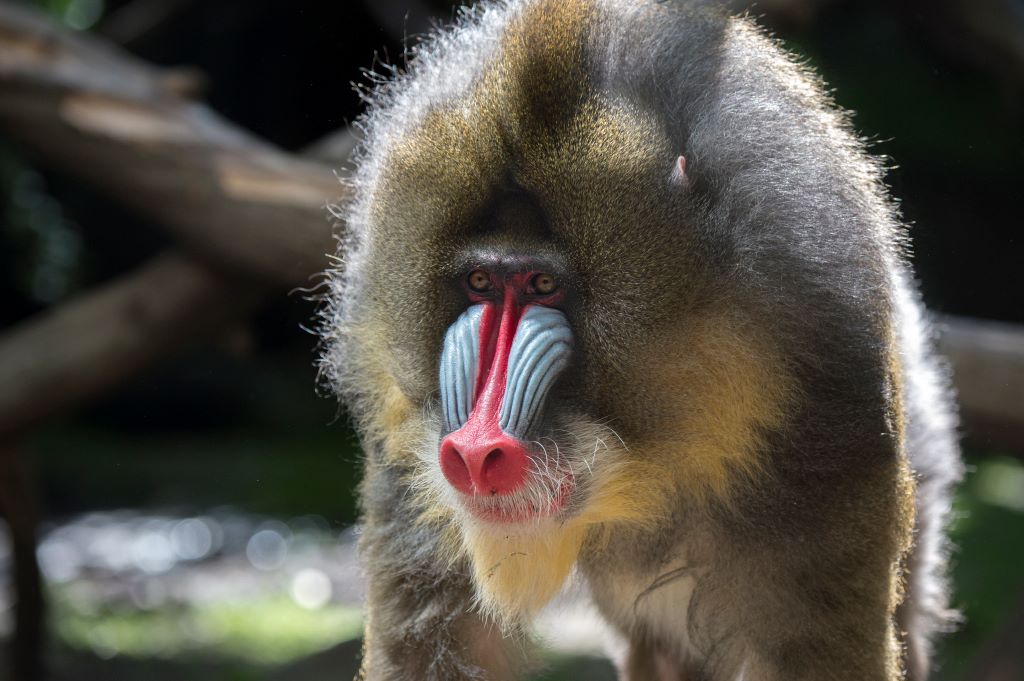
This male mandrill at the Bronx Zoo is constantly photographed, thanks to his bright colors – which become brighter when the animal is excited. Mandrills are the largest of all monkeys – and are shy and reclusive primates that live in the rain forests of equatorial Africa.
The safari begins with dinosaurs from the Permian period – which began about 300 million years ago – and concludes with the Cretaceous period, which ended about 65 million years ago.
Each dinosaur in the exhibit moves and vocalizes, and at the end of the ride there is a fossil dig for children, a Tyrannosaurus rex photo-op, a paleontologists’ tent where fossil replicas will be on display, and an interactive Stegosaurus that shows how the dinosaur animatronics work.
“The Dinosaur Safari experience is a total immersive experience,” said Jim Breheny, the Bronx Zoo Director. “The dinosaurs are realistic and through the entire safari visitors are surrounded by thick jungle foliage, which really adds to the experience and helps you imagine that you have traveled back in time to see these amazing creatures.”
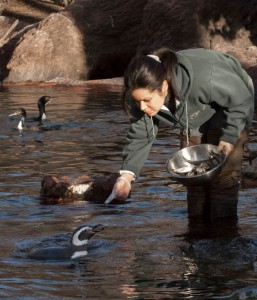
A keeper works at the Bronx Zoo, which is marking the beginning of National Keeper Awareness week beginning Saturday, July 20.
More information about the dinosaur exhibit, as well as information about tickets, is available at www.BronxZoo.com/dino.
Opened in 1899, the 265-acre Bronx Zoo offers an extensive list of animals, from the ever-popular lion to leaping lemurs and cave-dwelling crocodiles. Special rides and attractions include a bug carousel, butterfly garden, children’s zoo, Congo gorilla Forest, and Wild Asia Monorail.
The zoo is open daily from 10 a.m. to 5 p.m. weekdays, and 10 a.m. to 5:30 p.m. on weekends until October. Adult admission is $16.95, children ages 3 to 12 pay $11.95, and children under the age of 3 may enter for free. Seniors’ tickets are $14.95. Parking is $14 for cars and $16 for buses.
For more information, visit bronxzoo.com or call (718) 367-1010.
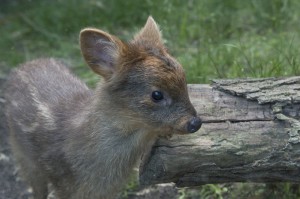
A female pudu fawn was born at the Queens Zoo in May. Pudus rank as one of the world’s smallest species of deer. This girl weighed just one pound at birth.
The 11-acre Queens Zoo, located at 53-51 111th St. in Flushing Meadows Corona Park, features more than 75 species from across the Americas, including pumas, parrots, Andean bears, and bison. A zoo spokeswoman said the sea lion feedings, which happen three times daily, are especially popular this summer.
The sea lion feedings happen at 11:15 a.m., 2 p.m. and 4 p.m. daily. During the sessions, the lions often high-five their keepers, show off their dives and catch fish on the fly. While the sea lions chow down, zookeepers demonstrate for the crowd how they check the animals’ health and give other routine care. Zoo-goers can also enjoy the zoo’s new cafe, which includes indoor and outdoor tables, overlooking the sea lion pool.
The Queens Zoo also features endangered speckled bears from South American’s Andes mountains, and there are a number of interactive exhibits for features and an aviary. A pudu – a species that ranks as one of the world’s smallest deer – was born at the zoo in May and weighed just one pound at birth. The petting zoo area is full of domesticated animals, including goats, sheep, cows and rabbits.
Admission is $8 for adults, $5 for children ages 3 to 12, and $6 for seniors. The Queens Zoo is open 10 a.m. to 5 p.m. Monday through Friday and 10 a.m. to 5:30 p.m. on weekends.
For more information, visit www.queenszoo.com or call (718) 271-1500.
Story and Photos by Anna Gustafson

